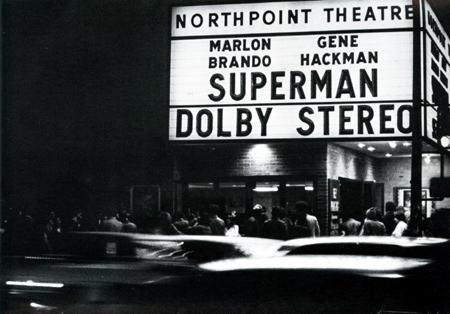Dolby Stereo Surround On 70mm | Read more at in70mm.com The 70mm Newsletter |
| Written by: John Iles, England, Dolby Sound Consultant, formerly Dolby Laboratories, now retired | Date: 02.11.2012 |
 Northpoint
Theatre in San Francisco. Early days of Dolby Stereo. Note the BIG logo on
the facade. Image from a Dolby brochure. Northpoint
Theatre in San Francisco. Early days of Dolby Stereo. Note the BIG logo on
the facade. Image from a Dolby brochure.In early 1978 Gordon McCullum and his crew at Pinewood were due to mix Dick Donner’s “Superman The Movie”. The release was to be in Dolby Stereo 35mm optical sound and 70mm. Gordon or “Mack” as he was known was a volatile character but at that time one of the few film re-recorders that was willing to experiment and push the boundaries. The Dolby 70mm format at that time was to use the two inner channels (Le & Re) for low frequency effects only. Left, Centre, Right and the surround channels were full range. The inner channels were not therefore fully utilised, normally only having signals during action sequences where greater low frequency output was required. Gordon and Max Bell the Dolby Consultant assigned to the film discussed the possibility of utilising the inner channels for a stereo surround track with the production. As the production was already very late the mix shouldn’t take any longer and to stand any chance of having prints available for cinemas the format would also have to be compatible with existing Dolby 70mm reproduction. I built an encoder for the studio and David Watts built a decoder as Dolby didn’t have any studio hardware available at that time. The idea was simply to use the inner channels to carry the high frequency left and right information whilst still carrying low frequency effects. The surround channel would be a sum of Left and right full range signals. The left and right surrounds in the cinema would have low frequency added back in from the mono surround channel. See figure below for the block diagram. | More in 70mm reading: "In 70mm and 6-track Dolby Stereo" All films presented in 70mm Dolby Stereo 70mm Blow Up List: 1978 | 1979 | 1982 |
 Encoder block diagram. Encoder block diagram.As the inner channels were now effectively wide range, as were the other channels, they would require A-type noise reduction encoding and decoding when played in the stereo surround format. Fortunately, the low frequency replay filters already in the CP100 contained low frequency expander characteristics as per the lowest frequency band found in Dolby A thus ensuring compatibility on standard installations. However, for the new format an additional box would be required to add to the CP100. I designed the encoding filters as 2nd order critically damped (12db per octave slope) low pass and high pass. Tests showed this to provide sufficient separation between the low frequency and surround channels. The design was changed for “Apocalypse Now” the 2nd film to have a stereo surround 70mm release. In the revised design the filters were made complementary. Like most engineering decisions there are compromises to be made and it’s about making the right compromise. If you ask an audio engineer about loudspeaker crossover networks (effectively the same requirements) you would find little agreement on what provided the best sonic result! The problem is that filters produce phase changes and low pass and high pass filters produce opposite shifts in phase. If a signal is of equal amplitude and summed after filtering it will be completely cancelled at the crossover point. This sounds extreme but we are talking about a very narrow band and only when signals are equal. In reality this is very hard to detect on a before and after test with “golden ear” listeners. A complementary filter which gets its characteristics by simply subtraction from the other filter will have no cancellation. The problem with this I found when we came to record “Pink Floyd the Wall”, the next stereo surround film also mixed at Pinewood. | |
 A complementary filter can only have a 6dB per octave slope and at crossover
it has a significant peak. Panning a narrow spectrum guitar from left to
right in the surrounds it actually appeared right to left! However, such
narrow spectrum signals are unusual and as we always monitored through the
encode/decode chain we could correct any such abnormalities. A complementary filter can only have a 6dB per octave slope and at crossover
it has a significant peak. Panning a narrow spectrum guitar from left to
right in the surrounds it actually appeared right to left! However, such
narrow spectrum signals are unusual and as we always monitored through the
encode/decode chain we could correct any such abnormalities. “Superman the Movie” had an outstanding soundtrack for its day thanks to the enthusiasm of Gordon and his Crew. “Apocalypse Now” also broke new ground and was another fine example of what you could achieve with the format. Today almost all films are made with stereo-surrounds (5.1) although not all Directors and re-recorders take full use of the possibilities. | |
| Go: back - top - back issues - news index Updated 22-01-25 |
